|
(11) | EP 0 007 210 B1 |
| (12) | EUROPEAN PATENT SPECIFICATION |
|
|
| (54) |
Ester derivatives of N-trifluoro-acetyl-N-phosphonomethylglycine and the herbicidal use thereof Esterderivate von N-Trifluoracetyl-N-Phosphonmethylglyzin und deren Verwendung als Herbizide Dérivés ester de la N-trifluoroacétyl-N-phosphonométhylglycine et leur utilisation comme herbicides |
|
|
|||||||||||||||||||||||
| Note: Within nine months from the publication of the mention of the grant of the European patent, any person may give notice to the European Patent Office of opposition to the European patent granted. Notice of opposition shall be filed in a written reasoned statement. It shall not be deemed to have been filed until the opposition fee has been paid. (Art. 99(1) European Patent Convention). |
[0001] This invention relates to ester derivatives of N-trifluoroacetyl-N-phosphonomethylglycine, to herbicidal compositions containing same and to herbicidal methods. More particularly, this invention relates to ester derivatives of N-trifluoroacetyl-N-phosphonomethylglycine wherein the groups bonded to the phosphorus atom are different than the group attached to the carboxyl group.
[0002] In accordance with U.S. Patent No. 3,970,695, issued July 20, 1976, N-perfluoroacyl-N-phosphonomethylglycines of the formula
wherein n is an integer of from 1 to 4 and m is 1 or 0 are produced by reacting a perfluoroacyl anhydride with N-phonomethylglycine in the presence of a perfluoroalkanoic acid to form the compound of the formula wherein m is 1 and then by hydrolysis to form the compounds wherein m is 0.
[0003] N-phosphonomethylglycine, its salts, amides, esters and other derivatives are disclosed in U.S. Patent No. 3,799,758 and are' shown to be post-emergent herbicides. Other derivatives of N-phosphonomethylglycine and the plant growth regulation use thereof are disclosed in U.S. Patent No. 3,853,530. The production of triesters of N-phosphonomethylglycine is disclosed in U.S. Patent Nos. 4,053,505 and 3,835,000 and in Belgian Patent 849,907.
[0004] Ester derivatives of N-trifluoroacetyl-N-phosphonomethylglycine wherein the ester groups attached to phosphorus and to the carboxyl group are all the same and are alkyl groups as disclosed by Rueppel et al, Biomedical Mass Spectrometry, Volume 3 (1976), pages 28-31. These compounds were prepared by preparing the N-trifluoroacetyl derivative of U.S. Patent No. 3,970,695 and then reacting it with diazobutane in n-butanol.
[0005] The novel N-trifluoroacetyl-N-phosphonomethylglycine esters of this invention are those mixed ester derivatives having the formula
wherein R is an alkyl group containing 1 to 10 carbon atoms or a phenyl group and R' is a member of the group consisting of allyl, naphthyl, benzyl and ring-substituted benzyl wherein the substituent is halo, cyano, nitro and trifluoromethyl, phenyl and phenyl substituted with one or two groups selected from the class consisting of halo, cyano, nitro and trifluoromethyl.
[0006] One aspect of the present invention is a herbicidal method which comprises contacting the plant or plant growth medium with a herbicidally effective amount of a compound of the formula
wherein R is an alkyl group containing from 1 to 10 carbon atoms or a phenyl group and R' is a member of the group consisting of allyl, naphthyl, benzyl and ring-substituted benzyl wherein the substituent is halo, cyano, nitro or trifluoromethyl, phenyl and phenyl containing one or two groups selected from the class consisting of halo, cyano, nitro and trifluoromethyl.
[0007] Another aspect of the present invention is a herbicidal composition characterized in that it contains an inert adjuvant and a compound of the formula
wherein R is alkyl group containing from 1 to 10 carbon atoms or a phenyl group and R' is a member of the group consisting of allyl, naphthyl, benzyl and ring-substituted benzyl wherein the substituent is halo, cyano, nitro or trifluoromethyl, phenyl and phenyl containing one or two groups selected from the class consisting of halo, cyano, nitro and trifluoromethyl.
[0008] As employed herein, the term "halo" includes chloro, bromo, iodo and fluoro. Preferably, the halo groups are chloro or fluoro.
[0009] Illustrative of the groups which R' represents are monosubstituted phenyl groups wherein the substituent is in the ortho, meta or para position, for example, chlorophenyl, broniophenyl, fluorophenyl, cyanophenyl, nitrophenyl and trifluorophenyl and the disubstituted phenyl groups wherein the substituents are the same or different and are located in the 2, 3, 4, 5 or 6 positions of the phenyl group, for example, dichlorophenyl, dibromophenyl, chlorocyanophenyl, dicyanophenyl, dinitrophenyl, bromonitrophenyl, chlorotrifluoromethylphenyl and the like. The ring-substituted benzyl groups include benzyl groups containing the substituents set forth above for the substituted phenyl groups.
[0010] Illustrative of the alkyl groups represented by R are, for example, methyl, ethyl, propyl, hexyl, cyclohexyl, decyl and their isomers. Preferably, R is a lower alkyl group, i.e., an alkyl group containing from 1 to 4 carbon atoms.
[0011] The novel compounds of this invention are produced by reacting an ester dichloride of N-trifluoroacetyl-N-phosphonomethylglycine having the formula
wherein R is as above defined with a hydroxy compound having the formula
wherein R' is as above-defined in an organic solvent and in the presence of a tertiary amine hydrogen chloride acceptor under essentially anhydrous conditions at a temperature of from about 10°C. to about 50°C. preferably at ambient temperatures.
[0012] In producing the compounds of this invention by the above reaction, the tertiary amine hydrogen chloride acceptor is preferably used in excess of stoichiometric to insure completeness of reaction. By the term " tertiary amine hydrogen chloride acceptor" as employed herein is meant tertiary alkylamines such as trimethylamine, triethylamine, tributylamine, trihexylamine and the like as well as aromatic tertiary amines such as pyridine, quinoline and the like.
[0013] The ratio of the reactants can vary over wide ranges. It is, of course, apparent to those skilled in the art that each chlorine atom in the N-trifluoroacetyl-N-phosphonomethylglycinyl dichloride will react with one alcohol group (R'-O-H) and that, therefore, one would employ the reactants in equivalent amounts. When employing an alcohol which is volatile, it is sometimes desirable to employ an excess of the alcohol. In other instances such with the phenols, it is sometimes preferred to use a slight excess of the glycinyl dichloride for ease of recovery of the product.
[0014] The ester dichlorides of Formula II employed as a reactant in producing the compounds of this invention are prepared by reacting an ester of N-phosphonomethylglycine of the formula _
wherein R has the above defined meaning with trifluoroacetic acid anhydride at temperatures of from about 10°C. to about 35°C., removing any excess anhydride and then treating the reaction product with excess thionyl chloride under refluxing conditions. The excess thionyl chloride is removed under vacuum to yield the dichlorides of Formula II.
[0016] The following non-limiting examples will serve to demonstrate to those skilled in the art the manner in which specific compounds within the scope of this invention can be prepared.
Example 1
[0017] A solution of N-trifluoroacetyl-N-(dichlorophosphonomethyl)glycinyl chloride (1,6 g, 0.005 mole) in ether (20 ml.) was added dropwise to a stirred solution of phenol (1.6 g, 0.017 mole) and triethylamine (1.72 g, 0.017 mole) in 40 ml. of ether. The mixture was stirred for 1 hour at 20°C., then filtered. The filtrate was concentrated in vacuo to an orange oil which was extracted into boiling petroleum ether. Concentration of the petroleum ether extract afforded phenyl N-trifluoroacetyl-N-(diphenoxy- phosphonomethyl)glycinate (2.2 g) as a very light yellow solid which crystallized on standing, m.p. chromatography on Florisil which yielded phenyl N-trifluoroacetyl-N-(diphenoxyphosphonomethyl)-glycinate as a solid, m.p. 166-1740C. with decomposition. (Florisil is a registered trademark).
Example 2
[0018] A solution of ethyl N-trifluoroacetyl-N-(dichlorophosphonomethyl)glycinate (1.65 g. 0.005 mole) in 20 ml. of ether was added dropwise to a solution of phenol (0.95 g, 0.010 mole) and triethylamine (1.05 g, 0.010 mole) in 30 ml. of ether. The reaction mixture was stirred for one hour, then filtered.
[0019] Concentration of the filtrate in vacuo afforded an oil which was extracted into boiling petroleum ether. Concentration of the petroleum ether extract afforded ethyl N-trifluoroacetyl-N-(diphenoxy- phosphonomethyl)glycinate (2.2 g) as a very light yellow solid which crystallized on standing, m.p. 59.5-63.50C.
Example 3
[0020] To a solution of p-nitrobenzyl alcohol (3.98 g, 0.026 mole) and triethylamine (2.63 g, 0.026 mole) in 150 ml. of dry ether was added ethyl N-trifluoroacetyl-N-(dichlorophosphonomethyl)glycinate (4.29 g, 0.013 mole) in ether (60 ml.). The resulting mixture was stirred for 16 hours at room temperature, then tetrahydrofuran (200 ml.) was added and the mixture filtered. The filtrate was concentrated in vacuo to give 4.05 g of a white solid, which was recrystallized from isopropanol to afford ethyl N-trifluoroacetyl-N-(bis(p-nitrobenzyloxy)phosphonomethyl)glycinate (2.6 g), m.p. 97-99°C.
Example 4
[0021] To a solution of ethyl N-trifluoroacetyl-N-(dichlorophosphonomethyl)glycinate (3.3 g, 0.01 mole) in 100 ml. of ether was added a solution of 2-naphthol (2.88 g, 0.02 mole) and triethylamine (2.02 g, 0.02 mole) in ether (75 ml.). The resulting mixture was stirred at 20°C. for 4 hours, then filtered. The filtrate was concentrated in vacuo to give ethyl N-trifluoroacetyl-N-(dinaphthyloxy- phosphonomethyl)glycinate as a light yellow gum (2.55 g).
Example 5
[0022] A solution of ethyl N-trifluoroacetyl-N-(dichlorophosphonomethyl)glycinate (4.95 g, 0.015 mole) in dry ether (150 mi.) was added dropwise with good agitation to a solution of m-chlorophenol (3.9 g, 0.03 mole) and triethylamine (3.03 g, 0.03 mole) in dry ether (75 ml.). The reaction was stirred at room temperature for 48 hours, then filtered to remove triethylamine hydrochloride. The filtrate was concentrated in vacuo and the residue was extracted into warm petroleum ether. The petroleum ether solution was concentrated in vacuo to afford ethyl N-trifluoroacetyl-N-(bis(m-chlorophenoxy)phosphonomethyl)glycinate as a light yellow oil. Short path distillation at 500/0.5 mm. removed a small amount of unreacted phenol and afforded pure ethyl N-trifluoroacetyl-N-(bis(m-chlorophenoxy)-phosphonomethyl)glycinate, N22D = 1.5178.
Example 6
[0023] A solution of ethyl N-trifluoroacetyl-N-(dichlorophosphonomethyl)glycinate (4.95 g, 0.015 mole) in ether (100 mi.) was added dropwise with good agitation to a solution of m-cyanophenol (3.57 g, 0.03 mole) and triethylamine (3.03 g, 0.03 mole) in dry ether (50 ml.). The reaction mixture was stirred at room temperature for several hours, then filtered. The filtrate was washed with a 5% solution sodium hydroxide, dried over magnesium sulfate, and concentrated in vacuo to afford ethyl N-trifluoroacetyl-N-(bis(m-cyanophenoxy)phosphonomethyl)-glycinate (3.4 g.) as a yellow gum, Np2 = 1.5185.
Example 7
[0024] A solution of ethyl N-trifluoroacetyl-N-(dichlorophosphonomethyl)glycinate (3.3 g, 0.01 mole) in dry ether (100 ml.) was added dropwise to a solution of m-trifluoromethylphenol (3.25 g, 0.02 mole) and triethylamine (2.02 g, 0.02 mole) in ether (50 ml.). The solution was stirred overnight at room temperature, then filtered. The filtrate was washed with 5% sodium hydroxide solution, dried over magnesium sulfate and concentrated to yield ethyl N-trifluoroacetyl-N-(bis(m-trifluoromethylphenoxy)-phosphonomethyl)glycinate as an oil, (2.1 g), N22D = 1.4584.
Example 8
[0025] A solution of ethyl N-trifluoroacetyl-N-(dichlorophosphonomethyl)glycinate (5.28 g, 0.016 mole) in dry ether (80 ml.) was added to a solution of m-nitrophenol (4.45 g, 0.032 mole) and triethylamine (3.23 g, 0.032 mole) in dry ether (100 ml.). The resulting mixture was stirred for 2.5 hours, then filtered and the filtrate was concentrated in vacuo. The residual oil was taken up in ether and precipitated with the petroleum ether to afford ethyl N-trifluoroacetyl-N-(bis(m-nitrophenoxy)-phosphonomethyl)glycinate as a glass (8.5 g), N26.6D = 1.5278.
Example 9
[0026] To a solution of m-chlorobenzyl alcohol (2.7 g, 0.019 mole) and triethylamine (1.9 g, 0.019 mole) in tetrahydrofuran (50 ml.) was added ethyl N-trifluoroacetyl-N-(dichlorophosphonomethyl)glycinate (3.13 g, 0.0095 mole) in tetrahydrofuran (25 ml.). The resulting mixture was stirred at 20°C. for 3 hours, then filtered. The filtrate was concentrated in vacuo to afford 5.2 g of yellow oil. This oil was chromatographed on silica gel eluting first with benzene, then with ethyl ether to afford 3.7 g of pure ethyl N-trifluoroacetyl-N-(bis)m-chlorobenxyloxy)phosphonomethyl)glycinate, N26.6D = 1.5181.
Example 10
[0027] To a solution of ethyl N-trifluoroacetyl-N-(dichlorophosphonomethyl)glycinate (6.6 g, 0.02 mole) in ether (200 ml.) was added a solution of allyl alcohol (2.32 g, 0.04 mole) and triethylamine (4.04 g, 0.04 mole) in ether (75 ml.). The resulting mixture was stirred for 3 days at 20°C. The mixture was filtered and the filtrate was concentrated in vacuo to afford a clear oil. This oil was':extracted into petroleum ether, then concentrated in vacuo to give 6.25 g of ethyl N-trifluoroacetyl-N-(diallyloxy- phosphonomethyl)glycinate as an oil, N26.6D = 1.4382.
Example 11
[0028] A solution of n-decyl N-trifluoroacetyl-N-(dichlorophosphonomethyl)glycinate (4.42 g, 0.01 mole) in ether (100 ml.) was treated with a solution of 2,4-dichlorophenol (3.26 g, 0.02 mole) and triethylamine (2.02 g, 0.02 mole) in ether (50 ml.). The resulting mixture was stirred overnight, then filtered. The filtrate was concentrated in vacuo to afford 6.9 g of n-decyl N-trifluoroacetyl-N-(bis(2,4-dichlorophenoxy)phosphonomethyl)glycinate as a yellow gum, N26.6D = 1.5083.
Example 12
[0029] The post-emergence herbicidal activity of the various compounds of this invention is demonstrated by greenhouse testing in the following manner. A good grade of top soil is placed in aluminum pans having holes in the bottom and compacted to a depth of .95 to 1.27 cm. from the top of the pan. A predetermined number of seeds of each of several dicotyledonous and monocotyledonous annual plant species and/or vegetative propagules for the perennial plant species are placed on the soil and pressed into the soil surface. The seeds and/or vegetative propagules are covered with soil and leveled. The pans are then placed on a sand bench in the greenhouse and watered from below as needed. After the plants reach the desired age (two to three weeks), each pan except for the control pans is removed individually to a spraying chamber and sprayed by means of an atomizer operating at a positive air pressure of approximately 1.46 kg/cm2 absolute. The atomizer contains 6 ml. of a solution or suspension of the chemical and an amount of a cyclohexanone emulsifying agent mixture so that the spray solution or suspension contains about 0.4% by weight of the emulsifier. The spray solution or suspension contains a sufficient amount of the candidate chemical in order to give application rates corresponding to those set forth in the tables. The spray solution is prepared by taking an aliquot of a 1.0% by weight stock solution or suspension of the candidate chemical in an organic solvent such as acetone or tetrahydrofuran or in water. The emulsifying agent employed is a mixture comprising 35 weight percent butylamine dodecylbenzene sulfonate and 65 weight percent of a tall oil ethylene oxide condensate having about 11 moles of ethylene oxide per mole of tall oil. The pans are returned to the greenhouse and watered as before and the injury to the plants as compared to the control is observed at approximately two and four weeks as indicated in the tables under WAT and the results recorded. In some instances, the four-week observations are omitted.
[0031] The plant species utilized in these tests are identified by letter in accordance with the following legend:
Example 13
[0032] The pre-emergent herbicidal activity of various compounds of this invention is demonstrated as follows. A good grade of top soil is placed in aluminum pans and compacted to a depth of .95 to 1.27 cm. from the top of each pan. A predetermined number of seeds or vegetative propagules of each of several plant species are placed on top of the soil in each pan and then pressed down. Herbicidal compositions prepared as in the previous example are applied by admixture with or incorporation in the top layer of soil.
[0033] In this method, the soil required to cover the seeds and propagules is weighed and admixed with a herbicidal composition containing a known amount of the active ingredient (compound of this invention). The pans are then filled with the admixture and leveled. Watering is carried out by permitting the soil in the pans to absorb moisture through apertures in the pan bottoms. The seed and propagule containing pans are placed on a wet sand bench and maintained for approximately two weeks under ordinary conditions of sunlight and watering. At the end of this period, the number of emerged plants of each species is noted and compared to an untreated control. The data is given in the following table.
[0034] The pre-emergent herbicidal activity index used below is based upon average percent control of each species as follows:
[0035] Plant species in the table are identified by the same code letters used in the previous example.
[0036] From the test results presented in Tables I and II, it can be seen that the post-emergent herbicidal activity of the compounds of this invention is, for the most part, general in nature. In certain specific instances, however, some selectivity is demonstrated. In this regard it should be recognized that each individual species selected for the above tests is a representative member of a recognized family of plant species.
[0037] From Table III, it can be seen that the preemergent herbicidal activity demonstrated some selectivity.
[0038] The herbicidal compositions, including concentrates which require dilution prior to application to the plants, of this invention contain from 5 to 95 parts by weight of at least one compound of this invention and from 5 to 95 parts by weight of an adjuvant in liquid or solid form, for example, from about 0.25 to 25 parts by weight of wetting agent, from about 0.25 to 25 parts by weight of a dispersant and from 4.5 to about 94.5 parts by weight of inert liquid extender, e.g., water, acetone, tetrahydrofuran, all parts being by weight of the total composition. Preferably, the compositions of this invention contain from 5 to 75 parts by weight together with the adjuvants. Where required, from about 0.1 to 2.0 parts by weight of the inert liquid extender can be replaced by a corrosion inhibitor or antifoaming agent, or both. The compositions are prepared by admixing the active ingredient with an adjuvant including diluents, extenders, carriers and conditioning agents to provide compositions in the form of finely-divided particulate solids, pellets, solutions, dispersions or emulsions. Thus, the active ingredient can be used with an adjuvant such as a finely-divided solid, a liquid of organic origin, water, a wetting agent, a dispersing agent, an emulsifying agent or any suitable combination of these.
[0039] The herbicidal compositions of this invention, particularly liquids and soluble powders, preferably contain as a conditioning agent one or more surface-active agents in amounts sufficient to render a given composition readily dispersible in water or in oil. The incorporation of a surface-active agent into the compositions greatly enhances their efficacy. By the term "surface-active agent", it is understood that wetting agents, dispersing agents, suspending agents and emulsifying agents are included therein. Anionic, cationic and nonionic agents can be used with equal facility.
[0040] Preferred wetting agents are alkyl benzene and alkyl naphthalene sulfonates, sulfated fatty alcohols, amines or acid amides, long chain acid esters of sodium isothionate, esters of sodium sulfosuccinate, sulfated or sulfonated fatty acid esters petroleum sulfonates, sulfonated vegetable oils, polyoxyethylene derivatives of phenols and alkylphenols (particularly isooctylphenol and nonylphenol) and polyoxyethylene derivatives of the mono-higher fatty acid esters of hexitol anhydrides (e.g., sorbitan). Preferred dispersants are methyl cellulose, polyvinyl alcohol, sodium lignin, sulfonates, polymeric alkyl naphthalene sulfonates, sodium naphthalene sulfonate, polymethylene bisnaphthalene- sulfonate and sodium N-methyl-N-(long chain acid) taurates.
[0041] When operating in accordance with the present invention, effective amounts of the compound or compositions of this invention are applied to the plants, or to soil containing the plants, or are incorporated into aquatic media in any convenient fashion. The application of liquid and particulate solid compositions to plants or soil can be carried out by conventional methods, e.g., power dusters, boom and hand sprayers and spray dusters. The compositions can also be applied from airplanes as a dust or a spray because of their effectiveness at low dosages. The application of herbicidal compositions to aquatic plants is usually carried out by adding the compositions to the aquatic media in the area where control of the aquatic plants is desired.
[0042] The application of an effective amount of the compound or compositions of this invention to the plant is essential and critical for the practice of the present invention. The exact amount of active ingredient to be employed is dependent upon the response desired in the plant as well as such other factors at the plant species and stage of development thereof, and the amount of rainfall as well as the specific glycine employed. In foliar treatment for the control of vegetative growth, the active ingredients are applied in amounts from about 0.112 to about 22.4 or more kilograms per hectare. In pre-emergent treatments, the rate of application can be from about 0.56 to about 22.4 or more kilograms per hectare. In applications for the control of aquatic plants, the active ingredients are applied in amounts of from about 0.01 parts per million to about 1000 parts per million, based on the aquatic medium. An effective amount for phytotoxic or herbicidal control is that amount necessary for overall or selective control, i.e., a phytotoxic or herbicidal amount. It is believed that one skilled in the art can readily determine from the teachings of this specification, including examples, the approximate application rate.
[0043] Although this invention has been described with respect to specific modifications, the details thereof are not to be construed as limitations, for it will be apparent that various equivalents, changes and modifications may be resorted to without departing from the scope thereof and it is understood that such equivalent embodiments are intended to be included herein.
1. A compound characterized in that it has the formula
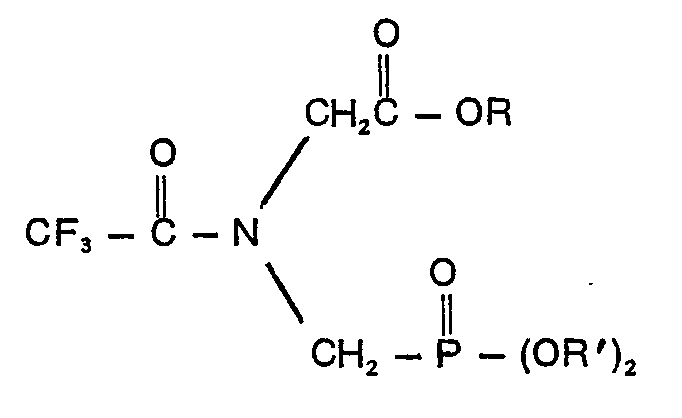
wherein R is an alkyl group containing from 1 to 10 carbon atoms or a phenyl group and R' is a member of the group consisting of allyl, naphthyl, benzyl and ring-substituted benzyl wherein the substituent is halo, cyano, nitro or trifluoromethyl, phenyl and phenyl containing one or two groups selected from the class consisting of halo, cyano, nitro and trifluoromethyl.
wherein R is an alkyl group containing from 1 to 10 carbon atoms or a phenyl group and R' is a member of the group consisting of allyl, naphthyl, benzyl and ring-substituted benzyl wherein the substituent is halo, cyano, nitro or trifluoromethyl, phenyl and phenyl containing one or two groups selected from the class consisting of halo, cyano, nitro and trifluoromethyl.
2. A compound according to Claim 1 characterized in that R' is phenyl or phenyl substituted
with one or two groups selected from the group consisting of halo, cyano, nitro and
trifluoromethyl.
3. A compound according to Claim 2 characterized in that R is a lower alkyl group.
4. A compound according to Claim 1 characterized in that R is a lower alkyl group
and R' is a naphthyl group.
5. A compound according to Claim 3 which is ethyl N-trifluoroacetyl-N-(diphenoxyphosphono-
methyl)glycinate, ethyl N-trifluoroacetyl-N-(bis(m-nitrophenoxy)phosphonomethyI)glycinate,
or ethyl N-trifluoroacetyl-N-(dinaphthyloxyphosphonomethyl)glycinate.
6. A herbicidal composition characterized in that it contains an inert adjuvant and
a compound of the formula

wherein R is an alkyl group containing from 1 to 10 carbon atoms or a phenyl group and R' is a member of the group consisting of allyl, naphthyl, benzyl and ring-substituted benzyl wherein the substituent is halo, cyano, nitro or trifluoromethyl, phenyl and phenyl containing one or two groups selected from the class consisting of halo, cyano, nitro and trifluoromethyl.
wherein R is an alkyl group containing from 1 to 10 carbon atoms or a phenyl group and R' is a member of the group consisting of allyl, naphthyl, benzyl and ring-substituted benzyl wherein the substituent is halo, cyano, nitro or trifluoromethyl, phenyl and phenyl containing one or two groups selected from the class consisting of halo, cyano, nitro and trifluoromethyl.
7. A herbicidal composition according to Claim 6 characterized in that R' is phenyl
or phenyl substituted with one or two groups selected from the group consisting of
halo, cyano, nitro and trifluoromethyl.
8. A herbicidal composition according to Claim 7 characterized in that R is a lower
alkyl group.
9. A herbicidal composition according to Claim 6 characterized in that R is a lower
alkyl group and R' is a naphthyl group.
10. A herbicidal composition according to Claim 6 characterized in that said compound
is ethyl N-trifluoroacetyl-N-(diphenoxyphosphonomethyl)glycinate, ethyl N-trifluoroacetyl-N-(bis(m-nitrophenoxy)-phosphonomethyl)glycinate
or ethyl N-trifluoroacetyl-N-(dinaphthyloxyphosphonomethyl)glycinate. '
11. A herbicidal method which comprises contacting the plant or plant growth medium
with a herbicidally effective amount of a compound characterized in that the compound
is of the formula
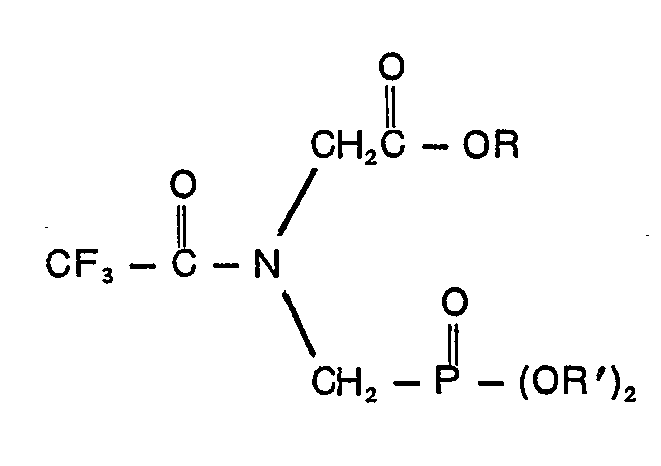
wherein R is an alkyl group containing from 1 to 10 carbon atoms or a phenyl group and R' is a member of the group consisting of allyl, naphthyl, benzyl and ring-substituted benzyl wherein the susbtituent is halo, cyano, nitro or trifluoromethyl, phenyl and phenyl containing one or two groups selected from the class consisting of halo, cyano, nitro and trifluoromethyl.
wherein R is an alkyl group containing from 1 to 10 carbon atoms or a phenyl group and R' is a member of the group consisting of allyl, naphthyl, benzyl and ring-substituted benzyl wherein the susbtituent is halo, cyano, nitro or trifluoromethyl, phenyl and phenyl containing one or two groups selected from the class consisting of halo, cyano, nitro and trifluoromethyl.
12. A herbicidal method according to Claim 11 characterized in that R' is phenyl or
phenyl substituted with one or two groups selected from the group consisting of halo,
cyano, nitro and trifluoromethyl.
13. A herbicidal method according to Claim 12 characterized in that R is a lower alkyl
group.
14. A herbicidal method according to Claim 11 characterized in that R is a lower alkyl
group and R' is a naphthyl group.
15. A herbicidal method according to Claim 11 characterized in that said compound
is ethyl N-trifluoroacetyl-N-(diphenoxyphosphonomethyl)glycinate, ethyl N-trifluoroacetyl-N-(bis(m-nitrophenoxy)-phosphonomethyl)glycinate
or ethyl N-trifluoroacetyl-N-(dinaphthyloxyphosphonomethyl)glycinate.
1. Composé, caractérisé en ce qu'il a la formule:
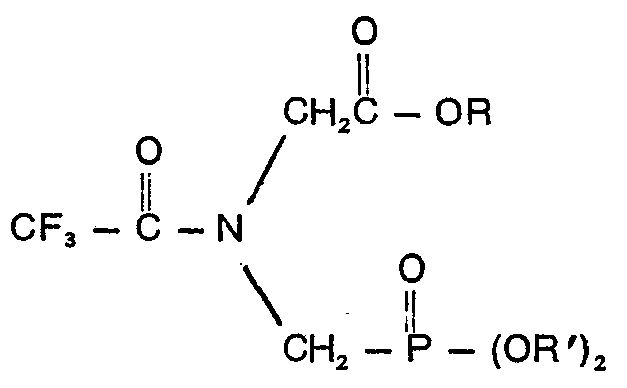
où R est un groupe alkyle contenant 1 à 10 atomes de carbone ou un groupe phényle et R' est un membre du groupe se composant de groupes allyle, naphtyle, benzyle et benzyle substitué sur le noyau où le substituant est un halogène, un groupe cyano, nitro ou trifluorométhyle, phényle et phényle contenant un ou deux groupes choisis dans la classe se composant d'halogènes, de groupes cyano, nitro et trifluorométhyle.
où R est un groupe alkyle contenant 1 à 10 atomes de carbone ou un groupe phényle et R' est un membre du groupe se composant de groupes allyle, naphtyle, benzyle et benzyle substitué sur le noyau où le substituant est un halogène, un groupe cyano, nitro ou trifluorométhyle, phényle et phényle contenant un ou deux groupes choisis dans la classe se composant d'halogènes, de groupes cyano, nitro et trifluorométhyle.
2. Composé selon la revendication 1, caractérisé en ce que R' est le groupe phényle
ou un groupe phényle substitué par un ou deux groupes choisis dans le groupe se composant
d'halogènes, de groupes cyano, nitro et trifluorométhyle.
3. Composé selon la revendication 2, caractérisé en ce que R est un groupe alkyle
inférieur.
4. Composé selon la revendication 1, caractérisé en ce que R est un groupe alkyle
inférieur et R' est un groupe naphtyle.
5. Composé selon la revendication 3, qui est le N-trifluoroacétyl-N-(diphénoxyphosphono-
méthyl)glycinate d'ethyle, le N-trifluoroacétyl-N-(bis(m-nitrophénoxy)phosphonométhyl)glycinate
d'éthyle ou le N-trifluoroacétyl-N-(dinaphtyloxyphosphonométhyl)glycinate d'éthyle.
6. Composition herbicide, caractérisée en ce qu'elle contient un adjuvant inerte et
un composé ayant la formule:

où R est un groupe alkyle contenant 1 à 10 atomes de carbone ou un groupe phényle et R' est un membre du groupe se composant de groupes allyle, naphtyle, benzyle et benzyle substitué sur le noyau, où le substituant est un halogène, un groupe cyano, nitro, ou trifluorométhyle, phényle et phényle contenant un ou deux groupes choisis dans la classe se composant d'halogènes, de groupes cyano, nitro et trifluorométhyle.
où R est un groupe alkyle contenant 1 à 10 atomes de carbone ou un groupe phényle et R' est un membre du groupe se composant de groupes allyle, naphtyle, benzyle et benzyle substitué sur le noyau, où le substituant est un halogène, un groupe cyano, nitro, ou trifluorométhyle, phényle et phényle contenant un ou deux groupes choisis dans la classe se composant d'halogènes, de groupes cyano, nitro et trifluorométhyle.
7. Composition herbicide selon la revendication 6, caractérisée en ce que R' est le
groupe phényle ou un groupe phényle susbtitué par un ou deux groupes choisis dans
le groupe se composant de groupes halo, cyano, nitro et trifluorométhyle.
8. Composition herbicide selon la revendication 7, caractérisée en ce que R est un
groupe alkyle inférieur.
9. Composition herbicide selon la revendication 6, caractérisée en ce que R est un
groupe alkyle inférieur et R' est un groupe naphtyle.
10. Composition herbicide selon la revendication 6, caractérisée en ce que le composé
est le N-trifluoroacétyl-N-(diphénoxyphosphonométhyl)glycinate d'éthyle, le N-trifluoroacétyl-N-(bis(m-nitro-
phénoxy)phosphonométhyl)glycinate d'éthyle ou le N-trifluoroacétyl-N-(dinaphtyloxyphosphono-
méthyl)glycinate d'éthyle.
11. Procédé herbicide qui consiste à mettre en contact la plante ou le milieu de croissance
de plante avec une quantité, efficace du point de vue herbicide, d'un composé, caractérisé
en ce que le composé a la formule:
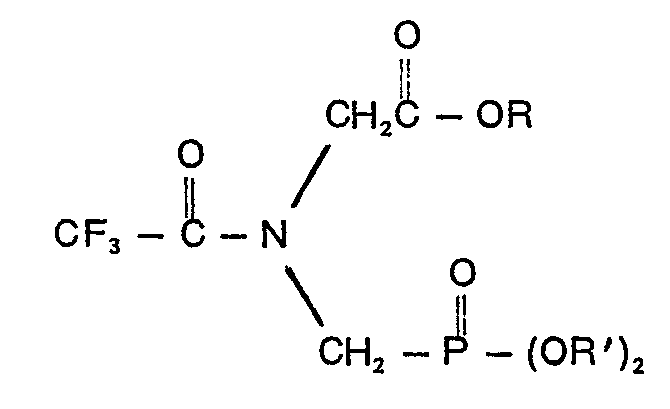
où R est un groupe alkyle contenant 1 à 10 atomes de carbone ou un groupe phényle et R' est un membre du groupe se composant de groupes allyle, naphtyle, benzyle et benzyle substitué sur le noyau où le substituant est un halogène, un groupe cyano, nitro ou trifluoromèthyle, phènyle et phènyle contenant un ou deux groupes choisis dans la classe se composant d'halogènes, de groupes cyano, nitro et trifluorométhyle.
où R est un groupe alkyle contenant 1 à 10 atomes de carbone ou un groupe phényle et R' est un membre du groupe se composant de groupes allyle, naphtyle, benzyle et benzyle substitué sur le noyau où le substituant est un halogène, un groupe cyano, nitro ou trifluoromèthyle, phènyle et phènyle contenant un ou deux groupes choisis dans la classe se composant d'halogènes, de groupes cyano, nitro et trifluorométhyle.
12. Procédé herbicide selon la revendication 11, caractérisé en ce que R' est le groupe
phényle ou un groupe phényle substitué par un ou deux groupes choisis dans le groupe
se composant d'halogènes, de groupes cyano, nitro et trifluorométhyle.
13. Procédé herbicide selon la revendication 12, caractérisé en ce que R est un groupe
alkyle inférieur.
14. Procédé herbicide selon la revendication 11, caractérisé en ce que R est un groupe
alkyle inférieur et R' est un groupe naphtyle.
15. Procédé herbicide selon la revendication 11, caractérisé en ce que le composé
est le N-trifluoroacétyl-N-(diphénoxyphosphonométhyl)glycinate d'éthyle, le N-trifluoroacétyl-N-(bis(m-nitro-
phénoxy)phosphonométhyl)glycinate d'éthyle ou le N-trifluoroacétyl-N-(dinaphtyloxyphosphono-
méthyl)glycinate d'éthyle.
1. Verbindung, gekennzeichnet durch die Formel
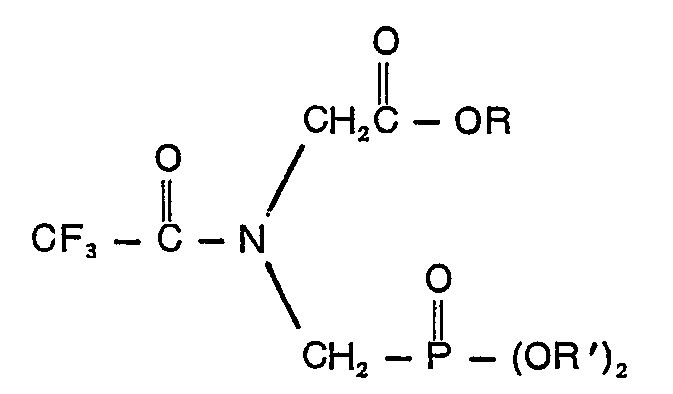
in der R eine Alkylgruppe mit 1 bis 10 Kohlenstoffatomen oder eine Phenylgruppe und R' Allyl, Naphthyl, Benzyl, durch Halogen, Cyano, Nitro oder Trifluormethyl ring-substituiertes Benzyl, Phenyl und/ oder ein oder zwei Halogen-, Cyano-, Nitro- und Trifluormethylgruppen enthaltendes Phenyl bedeuten.
in der R eine Alkylgruppe mit 1 bis 10 Kohlenstoffatomen oder eine Phenylgruppe und R' Allyl, Naphthyl, Benzyl, durch Halogen, Cyano, Nitro oder Trifluormethyl ring-substituiertes Benzyl, Phenyl und/ oder ein oder zwei Halogen-, Cyano-, Nitro- und Trifluormethylgruppen enthaltendes Phenyl bedeuten.
2. Verbindung nach Anspruch 1, dadurch gekennzeichnet, daß R' Phenyl oder durch eine
oder zwei Halogen-, Cyano-, Nitro- und Trifluormethylgruppen substituiertes Phenyl
Bedeutet.
3. Verbindung nach Anspruch 2, dadurch gekennzeichnet, daß R eine niedrige Alkylgruppe
ist.
4. Verbindung nach Anspruch 1, dadurch gekennzeichnet, daß R eine niedrige Alkylgruppe
und R' eine Naphthylgruppe ist.
5. Verbindung nach Anspruch 3, die Äthyl-N-trifluoracetyl-N-(diphenoxyphosphonomethyl)-glycinat,
Äthyl-N-trifluoracetyl-N-(bis(m-nitrophenoxy)phosphonomethyl)glycinat oder Äthyl-N-trifluoracetyl-N-(dinaphthyloxyphosphonomethyl)glycinat
ist.
6. Herbizide Zubereitung, dadurch gekennzeichnet, daß sie eine inertes Adjuvans und
eine Verbindung der Formel
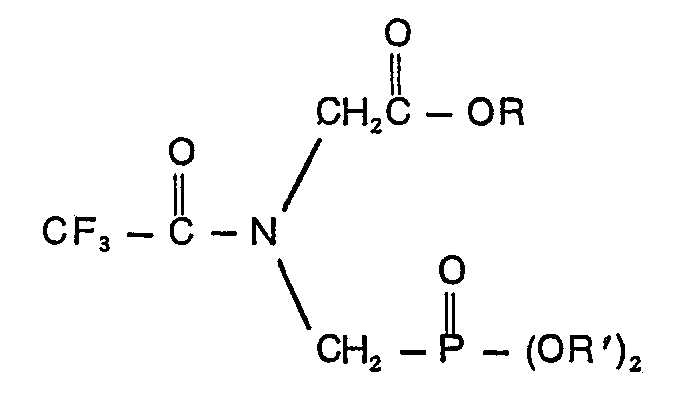
in der R eine Alkylgruppe mit 1 bis 10 Kohlenstoffatomen oder eine Phenylgruppe und R' Allyl, Naphthyl, Benzyl, durch Halogen, Cyano, Nitro oder Trifluormethyl ring-substituiertes Benzyl, Phenyl und/ oder ein oder zwei Halogen-, Cyano-, Nitro- und Trifluormethylgruppen enthaltendes Phenyl bedeuten.
in der R eine Alkylgruppe mit 1 bis 10 Kohlenstoffatomen oder eine Phenylgruppe und R' Allyl, Naphthyl, Benzyl, durch Halogen, Cyano, Nitro oder Trifluormethyl ring-substituiertes Benzyl, Phenyl und/ oder ein oder zwei Halogen-, Cyano-, Nitro- und Trifluormethylgruppen enthaltendes Phenyl bedeuten.
7. Verbindung nach Anspruch 6, dadurch gekennzeichnet, daß R' Phenyl oder durch eine
oder zwei Halogen-, Cyano-, Nitro- und Trifluormethylgruppen substituiertes Phenyl
bedeutet.
8. Herbizide Zubereitung nach Anspruch 7, dadurch gekennzeichnet, daß R eine niedrige
Alkylgruppe ist.
9. Herbizide Zubereitung nach Anspruch 6, dadurch gekennzeichnet, daß R eine niedrige
Alkylgruppe und R' eine Naphthylgruppe ist.
10. Herbizide Zubereitung nach Anspruch 6, dadurch gekennzeichnet, daß die Verbindung
Äthyl-N-trifluoracetyl-N-(diphenoxyphosphonomethyl)glycinat, Äthyl-N-trifluoracetyl-N-(bis(m-nitrophenoxy)-phosphonomethyl)glycinat
oder Äthyl-N-trifluoracetyl-N-(dinaphthyloxyphosphonomethyl)glycinat ist.
11. Herbizides Verfahren, bei dem man die Pflanze oder das Wachstumsmedium einer Pflanze
mit einer herbizid wirksamen Menge einer Verbindung in Kontakt bringt, dadurchgekennceichnet,
daß die Verbindung der Formel
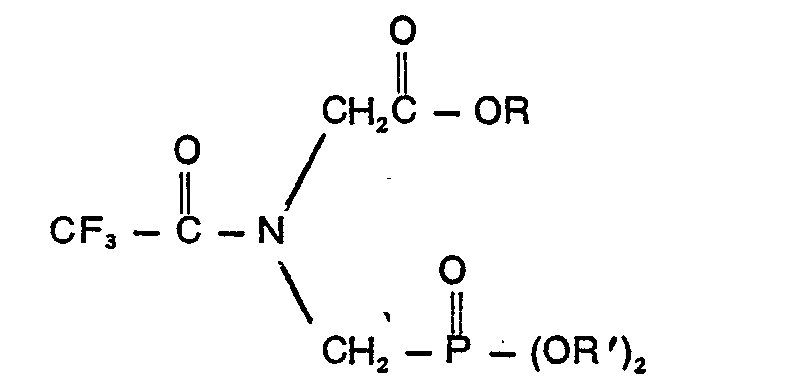
in der R eine Alkylgruppe mit 1 bis 10 Kohlenstoffatomen oder eine Phenylgruppe und R' Allyl, Naph- thyl, Benzyl, durch Halogen, Cyano, Nitro oder Trifluoromethyl ringsubstituiertes Benzyl, Phenyl und/oder zwei Halogen-, Cyano-, Nitro- und Trifluormethylgruppen enthaltendes Phenyl bedeuten.
in der R eine Alkylgruppe mit 1 bis 10 Kohlenstoffatomen oder eine Phenylgruppe und R' Allyl, Naph- thyl, Benzyl, durch Halogen, Cyano, Nitro oder Trifluoromethyl ringsubstituiertes Benzyl, Phenyl und/oder zwei Halogen-, Cyano-, Nitro- und Trifluormethylgruppen enthaltendes Phenyl bedeuten.
12. Herbizides Verfahren nach Anspruch 11, dadurch gekennzeichnet, daß R' Phenyl oder
durch eine oder zwei Halogen-, Cyano-, Nitro- und Trifluormethylgruppen substituiertes
Phenyl bedeutet.
13. Herbizides Verfahren nach Anspruch 12, dadurch, gekennzeichnet, daß R eine niedere
Alkylgruppe ist.
14. Herbizides Verfahren nach Anspruch 11, dadurch gekennzeichnet, daß R eine niedrige
Alkylgruppe und R' eine Naphthylgruppe ist.
15. Herbizides Verfahren nach Anspruch 11, dadurch gekennzeichnet, daß die Verbindung
Äthyl-N-trifluoracetyl-N-(diphenoxyphosphonomethyl)glycinat, Äthyl-N-trifluoracetyl-N-(bis(m-nitrophenoxy)-phosphonomethyl)glycinat
oder Äthyl-N-trifluoracetyl-N-(dinaphthyloxyphosphonomethyl)glycinat ist.
